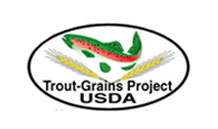
USDA - ARS
Trout-Grains Project
Ingredient Evaluation Program
A good aquaculture feed, starts not only with good ingredients but also with complete knowledge of the strengths and weaknesses of the ingredient . Many different sources of and type of ingredients can be used in aquafeeds, but nutritionists must know many things about each ingredient in order to determine the proper blend of ingredient for a specific feeding purpose.
In order to fully evaluate an ingredient, a 5 phase approach is applied to each new ingredient that is developed or supplied and these include Compositional Analysis, Palatability, Digestibility, Functionality, and Feeding trials. Evaluation of the compositional analysis allows us to determine the type of ingredient being evaluated and properly design trials for the rest of the evaluation. This phase does not usually result in rejection of an ingredient but may result in the conclusion of a low priority ingredients. The second phase is to determine the effect of the ingredient on feed intake, or palatability of the diet. If an ingredient decrease feed consumption the value of that ingredient is significantly reduced. Palatability enhancers can be added to overcome unpalatable ingredients but this approach can be expensive. Also, reduced feed intake could be due to the presence of deleterious compounds which is unacceptable. The third phase is to determine the digestibility of the nutrients, or how much of a nutrient in an ingredient the fish can actually digest and absorb. Some protein are highly digestible, such as fish meal and soy protein concentrate and other ingredients such as feather meal can be very high in protein but the availability or digestibility of that protein is very low. This determination will have a major impact on the economic value of the ingredient, but small decreases in digestibility can be accounted for in the diet formulation and do not necessarily eliminate or elevate a particular ingredient. The fourth phase of the evaluation, functionality, involves the effect of the ingredient on the process of feed production and the physical quality of the complete feed. This is a very important aspect of the overall value of an ingredient to feed manufacturers. The final phase of evaluation involves fish feeding trials. These start as laboratory trials and when successful are expanded to pilot scale and then production studies that are conducted at commercial farms.
A more detailed description of each phase is listed below.
Phase 1: Compositional Analysis
This phase of the evaluation involves a detailed laboratory analysis of the ingredient which results in list of nutrient composition(Excel 2.99MB) and anti-nutrients(Excel 2.99MB). Anti-nutrients are compounds found in plant or animal products that have a deleterious effect on the fish. In plants these compounds evolved as a protective mechanism for the seed to reduce consumption by birds and other animals. For example some compounds have a bitter flavor and others cause an upset stomach so the animal doesn't feed on those plants again. In some animal products compounds such as putrescene and cadaverne decrease feed intake of fish and are a measure of lower quality meals. Once the complete compositional profile is known, the potential for that ingredient to be a functional ingredient can be determined. If the ingredient is too low in one nutrient, protein for example, or high in another (i.e. minerals) the ingredient may be a good candidate for modification prior to evaluation in order to improve both its nutritional and economic value.
Phase 2: Palatability
While some ingredients might have few or none of the known anti-nutrients and good levels of essential nutrients, inclusion of that ingredient in the diet may still decrease feed intake. This effect is often referred to as the palatability of an ingredient. Reduced growth and perhaps other problems is the result of inclusion of a low palatability ingredient unless palatability enhancers are added along with the ingredient. Substances such as betaine and specific amino acids have been shown to increase feed intake in fish.
Palatability of an ingredient can be determined by either a simple short term (2 week) or a longer term feeding study (typically 9-12 weeks). Feed intake of fish fed a standard basal diet is compared to fish fed a diet containing the new ingredient is compared to fish fed the basal diet.
Phase 3: Digestibility
Apparent digestibility coefficients (ADCs) are determined for each nutrient in each ingredient. This number represents the percentage of that ingredient that is digested and absorbed by the fish. Many methods have been developed and used over the years with fish, and we use the methods described by Cho et al. (1982) and Forster (1999) to estimate ADCs. All diets are double labeled using chromic oxide and yttrium oxide as the inert markers in order to have a reference in both the feed and the feces. By measuring the ratio of nutrient to marker in the feed and comparing that to the ratio of marker to the nutrient in the feces, one can determine mathematically how much of that nutrient was absorbed by the fish.
A complete description of the methods used and data produced in this step can be found on the tab labeled "Ingredient Database".
Phase 4: Functionality Trials
This phase involves evaluation of how the ingredient effects the manufacturing of the feed and the result of the ingredient on the quality of final pellet. The functionality of an ingredient is very important to feed manufacturers since it can increase operating costs or decrease product quality. Read a full description of this evaluation.
Phase 5: Feeding Trials
The final phase of evaluation for an ingredient is to determine the effect of the new ingredient on growth, feed efficiency, nutrient retention, fish heath and sensory characteristics of the final product (i.e. flavor, texture, aroma). It can take several studies to determine all of these effects, but answers to those questions are critical if the new or modified ingredient is going to be used in commercial feeds.
